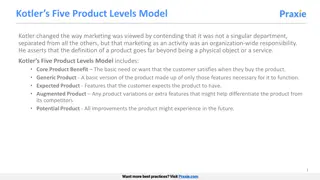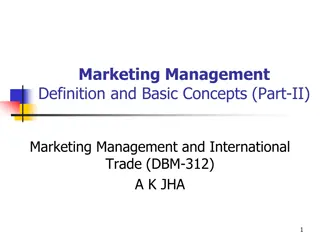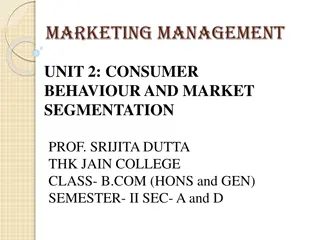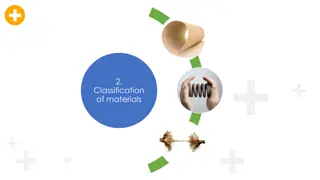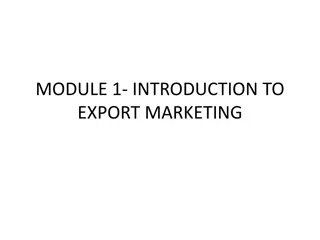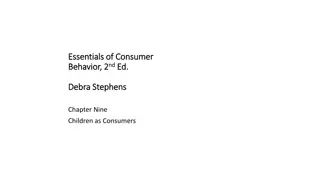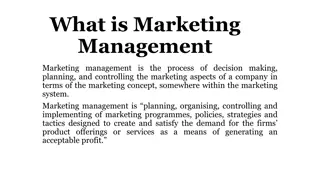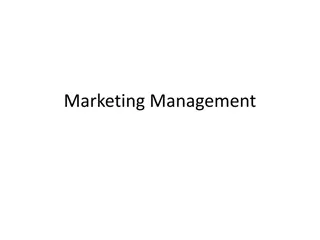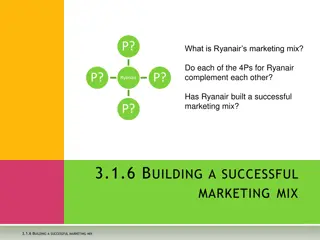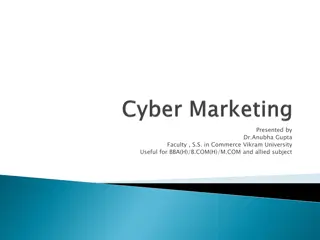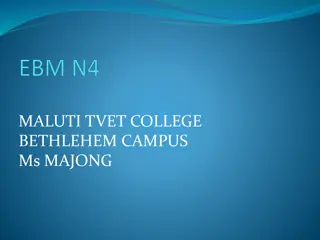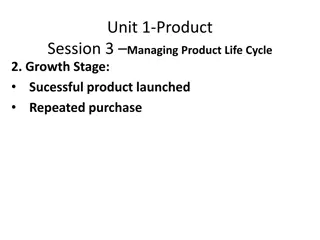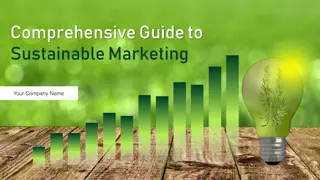Understanding Product Classification and Importance in Marketing
Products play a vital role in marketing, satisfying customer needs and wants. In this study unit, we explore the definitions of products, the five levels of a product, classification based on durability and use, and the significance of products in the marketing mix. Understanding these concepts is essential for creating successful marketing strategies.
Download Presentation

Please find below an Image/Link to download the presentation.
The content on the website is provided AS IS for your information and personal use only. It may not be sold, licensed, or shared on other websites without obtaining consent from the author. Download presentation by click this link. If you encounter any issues during the download, it is possible that the publisher has removed the file from their server.
E N D
Presentation Transcript
MARKETING MANAGEMENT UNIT 3:PRODUCT PROF. SRIJITA DUTTA THK JAIN COLLEGE CLASS-B.COM (HONS and GEN) SEMESTER- II SEC- D
PRODUCT A Product is anything that can be offered to a market to satisfy a want or need. Products that are marketed include physical goods, services, events & experiences, people, places, real and financial properties, organizations, digital products, information and ideas. People satisfy their needs and wants with products.
DEFINITIONS According to Philip Kotler, A product is anything that can be offered to a market for attention , acquisition, use or consumption; it includes physical objects, services, personalities, place, organizations and idea. According to William J. Stanton, A product is a set of tangible and intangible attributes, including packaging, colour, price, manufacturer s and retailer s prestige and services, which the buyer may accept as offering satisfaction of wants and needs.
Five Product Levels A product has five levels or dimensions. According to Philip Kotler these are as follows: The core benefits associated with a product forms the basic level. For example, we purchase a winter garment to protect us from cold. Hence, it answers the question, what the buyer is really buying? The tangible product or the physical product is the second level of the product. This represents characteristics such as quality, features, design, brand name, and packaging, etc. associated with a product or service. For example, we buy a winter garment from Monte Carlo, which meets our specifications regarding quality, design, brand name, etc. The expected product is the stage a marketer develops and offers such a product or service in the which is packed with attributes to meet expectation of customers. The augmented product implies that a product offered in the market must be supported by customer service and other benefits to be able to offer more to the customers than their expectations. The potential product, which encompasses all the possible augmentations and transformations the product might undergo in the future.
Classification of Products NON DURABLE GOODS COLD DRINKS, ALL FMCG PRODUCTS DURABLE GOODS REFRIGERATORS, HEAVY MACHINES ON THE BASIS OF DURABILITY HAIRCUT, REPAIRS SERVICES CONVENIENCE GOODS PRODUCT SHOPPING GOODS CONSUMER GOODS SPECIALITY GOODS UNSOUGHT GOODS ON THE BASIS OF USE MATERIALS AND PARTS CAPITAL GOODS INDUSTRIAL GOODS SUPPLIES AND BUSINESS SERVICES
IMPORTANCE OF PRODUCT Key to marketing Main element to marketing mix Tool for survival Means of want satisfaction Helps in sales promotion Tools of competition Making profit
Product Mix A product mix (also called product assortment) is the set of all products and items that a particular seller offers for sale. A company s product mix has a certain width, length, depth, and consistency. Product Mix of HUL(Illustrative Only) Colour Cosmetic s Hair Care Skin Oral care Deodorants Soaps and detergents Toilet Soaps Care Lakme Sunsilk, Clinic Fair and Lovely, Ponds Pepsodent, Close-up Axe, Denim, Rexona Surf, Rin, Wheel, Sunlight, Vim Liril, Lifebu oy, Lux, Pears, Hama m, Savlon
BRANDING As per the American Marketing Association definition, a brand is a name, term, sign, symbol, or design, or a combination of all of these elements that companies use to convey the identity of its goods or services to customers and diferentiate them from the products or services of the competitors. Scope of branding includes physical goods (Maruti Car, Kissan Jam, Cinthol Soap), services (Axis Bank, Jet Airways), stores (Big Bazar, Spencers, Shopper Stops), people (Amir Khan, Kareena Kapoor, Sachin Tendulkar), (Incredible India), organisations ( UNICEF, Ramkrishna Mission) or ideas (Blood Donation, Fight Against Aids). places
Brand Experience, Brand Recognition and Brand Awarness The experiential aspect consists of the sum of all points of contact with the brand is known as the brand experience. A successful brand is one which creates and sustains a strong, positive, and lasting impression in the mind of a buyer. An organization s approach to branding depends on its overall product mix and individual line strategy. A brand which is widely known in the marketplace acquires brand recognition. Brand Awareness refers to customer s ability to recall and recognize the brand under different conditions and link to the brand name, logo, and so on to certain associations in memory.
Brand Equity and Trade Mark Brand Equity refers to a set of assets and liabilities linked to a brand- its name and symbol- that add to the value provided by a product or service. It may be reflected in the way consumers think, feel, and act with respect to the brand, as well as in the prices, market share, and profitability the brand commands for the firm. The equity of a product has five major determinants- awareness, quality perception, loyalty, patents and trademarks. Registered brands are known as trademarks. When a brand is registered and legalized it becomes a trademark. For popular brands, that are more susceptible to imitation, trademark is a legal right to protect the brand name or the other brand elements. Trademarks assure the customers that they are purchasing an authentic brand at a time when piracy is evidently on the rise.
Types of Brands Manufacturers Brands are those that are branded directly by the manufacturers who have invested heavily on building them. Surf, Rin, Lux, Colgate, Cadbury s, Coca-Cola, Pepsietc. are examples of manufacturers brands. Resellers Brand are those brands that are developed and owned by the resellers. Big Bazar, Shoppers Stop, Spencer s etc. have their own brands. Generic brands are associated with products like rice, wheat, doormats, broomsticks, paper napkins etc. which are not specifically advertised and are sold by grocery stores at a lower price than those o identical branded products.
How a brand to be selected? Selecting a brand name is an important task. The brand name should be carefully chosen since a good name can add greatly to a product s success. Desirable qualities of a good brand name include: It should suggest something about the product s benefits and qualities. It should be easy to pronounce, recognise, and remember. It should be distinctive. It should translate easily into foreign languages. It should be capable of registration and legal protection. Once chosen, the brand name must be protected.
Sponsorship Options for Branding A manufacturer has four sponsorship options: 1. Manufacturer s brand: It is a brand created and owned by the producer of a product or service. 2. Private brand : It is a brand created and owned by a reseller of a product or service. 3. Licensed brand: It may happen when a company sells its output under another brand name. 4. Co-branding: It occurs when two companies go together and manufacture the same product combined brands create broader customer appeal and greater brand equity.
Labelling Labelling is the process of attaching labels on a product or on its package for recognition of a product, and to be able to provide detailed information about the product to the customers. Labels must comply with legal obligations and must display information such as name of the product, name of the manufacturer, manufacturing and expiry dates, weight, MRP, information regarding usage, etc.
Types of Labelling Brand Label: Through this type of labelling only the name of the brand expressed. For example, label of Titan wrist watch shows only the name of the brand Titan . Descriptive Label: Through this type of labelling various information pertaining to a product is passed on to the customers, such as, name of the product, name of the manufacturer, manufacturing date, expiry date, MRP, weight, instructions about product usage etc. For example, label of Coca-Cola shown below is an example of descriptive labelling. Grade Label: through this type of labelling information regarding grade and quality of a product is conveyed to the customers. For example, Jai Engineering Works Ltd., Kolkata manufacturers fans under the brand name Usha .
Packaging Packaging refers to all activities associated with enclosing products in specially designed bottles, boxes, packets, paper cartoons, tubes, etc. keeping in view the nature of the product, to protect it from damage, pilferage, spoilage etc. and at the same time to be able to attract the customers. Types of Packaging: 1. Primary Packaging refers to enclosing a product in such a container without which the product cannot be marketed or offered for sale in a market. For example, toothpaste being packaged in a tube is a case of primary packaging. 2. Secondary Packaging refers to enclosing a product in such a container which will ensure that the primary packages remain un- tampered and take care of the product till it reaches the ultimate users. For example, a tube of toothpaste being packed in a cardboard box is a case of secondary packaging. 3. Transporation Packaging is necessary to protect a product in the course of its transportation and storage. For example, enclosing toothpaste boxes in a big corrugated box is a case of transportation packaging.
Characteristics of a Good Packaging Convenient Attractive Communicative Good Packaging Economical Protective








